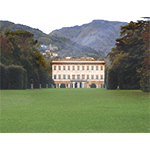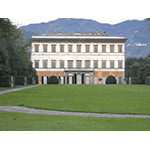Villa Reale di Marlia
Purchased in 1517 by the Buonvisi family, in 1651 the villa passed to Oliviero and Lelio Orsetti to whom we owe the seventeenth-century arrangement of the garden and the construction of the Palazzina dell’Orologio, so called for the presence of a clock that dominates the facade. In 1806, the entire complex was purchased by Elisa Baciocchi Bonaparte, sister of Napoleon and princess of Lucca and Piombino. Elisa doubled the property with the purchase of the Villa del Vescovo from the Bishop’s Estate, as well as other bordering lands. In 1811 began the renovation of the garden and late-renaissance palazzo, which was given a neoclassical style. The following year, the ballroom was frescoed by Stefano Tofanelli with The Dance of the Hours. Elisa also ordered the construction of a sumptuous entrance to the park and villa, characterised by two small buildings in the neoclassical style, facing a semicircular courtyard.
The garden was planted in the second half of the 17th century, and its upper portion still conserves the original appearance and layout. Characterised by the palazzo’s spacious forecourt, behind the villa it maintains the spectacular and scenographic Water Theatre, arranged around a semicircular pond embellished by flower vases, statues of divinities (Jupiter, Saturn, Adonis, Pomona), gushing water, and waterfalls. One of the two avenues parallel to that of the entrance leads to the Palazzina dell’Orologio, the other to the lemon-tree garden. Perpendicular to the latter is the avenue that leads to the vegetation theatre where plays were staged. The lemon garden is divided into two parts: the lower portion is occupied by four rectangular beds; the upper one by a large fish-pond bordered by a simple balustrade and ending in an exhedra in tufa and smooth stone. On the border of the fish-pool are two statues of Giants, representing the rivers Arno and Serchio, which spurt water. Created in 1652, the vegetation theatre also has a circular-plan vestibule, arranged around a fountain. The stone seats, upper-circle boxes for viewers, arranged in a semicircle, the wings and elements of the theatrical space, are all bordered by yew hedges, some of them 5.50 metres high.
The lower portion has considerably changed compared to the sixteenth-century garden of the Villa del Vescovo. The arrangement ordered by Elisa indeed presents a series of tree clusters, arranged asymmetrically, and with slightly sloping lawns. A bit further downhill lies a lake surrounded by woods populated by deer, goats and merino sheep. The woods are traversed by brooks and footpaths, and have many tree species, including beech, pines, holm-oaks, oaks, linden and plane trees. Many rare species were also introduced, such as magnolias, weeping willows, American oaks, and mimosa, found in the Naples area by gardener Raimondo Grimaldi. Of the Villa del Vescovo garden, there remains the nymphaeum, called Pan’s Grotto, which around 1920 was connected to the rectangular-shaped flower garden in the Deco style, characterised by a large pond from which various canals depart.
In 1814, the property passed to Marie Louise of Bourbon who commissioned Lorenzo Nottolini to construct an astronomical observatory (the Specola) inside the park. After becoming state property, and then of the Bourbons of Capua, the complex was purchased in 1923 by the Pecci Blunt counts who restored the villa and park.
****************************
Texts by Graziano Magrini
English translation by Victor Beard
Last update 15/gen/2008





